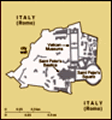Advertisement
Published: August 7th 2009
After visiting the Vatican museum, we proceeded to visit St. Peter's Basilica, the mother of all churches. St. Peter's Basilica is undoubtedly the greatest Catholic Church on earth, both in size and in significance. It was said the Church built on the site where St. Peter was martyred by the Romans, crucified head down. The church altar contains the bones of St. Peter (so goes the Christian legend). The Church symbolizes the power and legitimacy of the papacy and through which, Popes throughout the centuries wielded hard and soft powers over the temporal and "spiritual" realms. According to the Catholics, the power of St. Peter is derived from Jesus's own words:
"And I say to thee: That thou art Peter , and upon this rock I will build my church , and the gates of hell shall not prevail against it. And I will give to thee the keys of the kingdom of heaven. And whatsoever thou shalt bind upon earth, it shall be bound also in heaven: and whatsoever thou shalt loose on earth, it shall be loosed also in heaven".
Before entering the Church, the guards require the visitors to comply with certain dress
protocols, such as no mini skirts, no swimming suites etc. These I can understand. However, where most people failed the test, especially for women, is the baring of shoulders. Many women wore sleeveless shirts and were stopped by the guards from entering the house of God. Why is baring of the shoulders a taboo to religion is something not quite understood by me, however, I guess the bouncers are always right, infallible if you will, if one wants to enter and stay in the dance club...
I quickly lost Joanne amongst the sea of crowd. But I continued touring the St. Peter's Basilica. In front of the Basilica is St. Peter's square where the giants pillars encircle the space and on top of which stand statues of saints and biblical personalities.
Inside the church, there are different chapels and praying places, filled with solemn artworks and statues. I will go through 4 of the most notable pieces of devotional artworks here.
1) Michaelangelo's Pieta
This is the most famous masterpiece in St. Peter's Basilica by Michaelangelo. "Pieta" is a typical subject matter where countless artists have attempted the theme before. It depicts the scene where Maria
held his son Jesus after his crucifixion. However, I agree with one interpretation that when you look at Michaelangelo's Pieta, it is quite different from all other works of similar theme. Jesus's body seems to flow down like a river on Maria, who is seated like a mountain with extraordinary broad shoulders, and there is no drama, no insidious sorrow from Maria. Maria's face is improbably young for a mother figure. The two figures seem to be in perfect harmony and unity- they belong to each other. This seems to depict some sort of archetypal companionship and love between two people- which we all long for in our short existence on earth.
2) St. Peter's Statue
St. Peter's statue sits near the central altar with kingly majesty. It is a custom for the visitors to touch his feet for his heavenly blessing. Over the years, due to the amount of visitors touching the bronze feet, they have been gradually worn out. You can see in the picture someone was performing the ritual while being photographed by me.
3) The Central Altar
The central altar hosts the bone of St. Peter and is where the Pope often
conducts prayers and communion at. The four giant pillars are one of the most recognizable symbol in the Basilica.
4) Coloured marble depicting the end of time
Beside the central altar is a large sculpture made out of a precious coloured marble. It depicts a skeleton, symbolizing death, whose head and face are covered and hidden in a hood. His right hand is holding a hourglass/ sand timer. The message is that we as humans, never know when death or end of time will come (hidden in the hood, unseen). However, surely that moment will arrive as the sand eventually runs its course, then death/ final judgment will lift its head/ arrive. The artist wants us to live our lives bearing that allegory in mind.
In addition, I also recalled the following words in William Byrd's Cantiones Sacrae "Memento homo, quod cinis es, et in cinerem reverteris."
Finally I will show you some pictures of the famed Swiss guards. Some of them stood in solemn diligence, in other places, the Swiss guards appeared more spontaneous- they talked, smiled and relaxed while performing their duties.
With that, I will wrap up my account of my visit.
at the Vatican. I will write a concluding blog on Italy next time.
Hasta luego.
Advertisement
Tot: 0.369s; Tpl: 0.014s; cc: 6; qc: 44; dbt: 0.163s; 1; m:domysql w:travelblog (10.17.0.13); sld: 1;
; mem: 1.1mb






















